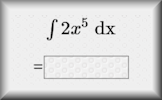Here are some specific activities, investigations or visual aids we have picked out. Click anywhere in the grey area to access the resource.
 Integration Exercises on indefinite and definite integration of basic algebraic and trigonometric functions.
Integration Exercises on indefinite and definite integration of basic algebraic and trigonometric functions. Integration Video You can't possibly learn all about integration from a 28 minute video so all that this resource can do is provide a quick revision to help you do the online exercise.
Integration Video You can't possibly learn all about integration from a 28 minute video so all that this resource can do is provide a quick revision to help you do the online exercise.
Here are some exam-style questions on this statement:
- "The graph of \(f(x)=8-x^2\) crosses the x-axis at the points A and B." ... more
- "The acceleration, \(a\) ms-2 , of an object at time \(t\) seconds is given by" ... more
- "(a) Find \(\int (4x+5) dx\)." ... more
- "Given that \( \frac{dy}{dx} = \sin(x + \frac{\pi}{3})\) and \(y = 5\) when \(x = \frac{8\pi}{3}\), find \(y\) in terms of \(x\)." ... more
- "A particle moves in a straight line. During the first nine seconds the velocity, \(v\) ms-1 of the particle at time \(t\) seconds is given by:
$$ v(t) = t \cos(t+5) $$
The following diagram shows the graph of v:
" ... more - "The following diagram shows part of the graph of:" ... more
- "Consider the graph of the function \(f(x)=x^2+2\)." ... more
- "(a) Express the algebraic fraction" ... more
- "Make a sketch of a graph showing the velocity (in \(ms^{-1}\)) against time of a particle travelling for six seconds according to the equation:" ... more
- "Find the value of \(a\) if \(\pi \lt a \lt 2\pi\) and:" ... more
- "This graph represents the function \(f:x\to a \cos x, a\in \mathbf N\)" ... more
- "Find \(f(x)\) if \(f'(x)=6 \sin2x\) and the graph of \(f(x)\) passes through the point \((\frac{\pi}{3},11)\)." ... more
- "The diagram shows a sketch of the curve C with equation:" ... more
- "The following diagram shows the graph of \(f(x) = \cos(e^x) \; \text{for} \; 0 \le x \le 0.5\)." ... more
Click on a topic below for suggested lesson Starters, resources and activities from Transum.
Furthermore
Integration is a fundamental concept in calculus that represents the accumulation of quantities. Specifically, when considering the area of a region enclosed by a curve \( y = f(x) \) and the x-axis, where \( f(x) > 0 \), integration allows us to calculate this area. The area under the curve from \( x = a \) to \( x = b \) is given by the definite integral:
$$ \int_a^b f(x) \, dx $$For example, let's consider the function \( f(x) = x^2 \) over the interval [0, 2]. The area under the curve and above the x-axis between these two points can be found using the integral:
$$ \int_0^2 x^2 \, dx \\ = \left. \frac{1}{3}x^3 \right|_0^2 \\ = \frac{1}{3}(2^3) - \frac{1}{3}(0^3) \\ = \frac{8}{3} $$Thus, the area of the region enclosed by the curve \( y = x^2 \) and the x-axis between \( x = 0 \) and \( x = 2 \) is \( \frac{8}{3} \) square units.
If you use a TI-Nspire GDC there are instructions useful for this topic.
This video on Antidifferentiation is from Revision Village and is aimed at students taking the IB Maths Standard level course
This video titled Overview of Integral Calculus is from Revision Village and is aimed at students taking the IB Maths Standard level course.
This Finding Areas Under Curves video is from Revision Village and is aimed at students taking the IB Maths Standard level course
How do you teach this topic? Do you have any tips or suggestions for other teachers? It is always useful to receive feedback and helps make these free resources even more useful for Maths teachers anywhere in the world. Click here to enter your comments.

